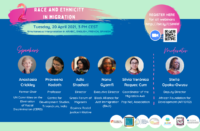Fabrizio Parrilli
April 20, 2021

The online panel discussion held on 20th April 2021 focused on the complex concepts of race and ethnicity within the issue of migration, and its main aim was to give a broader understanding of the topics discussed from both a global perspective as well as a regional perspective.
The event was jointly organized by the following organisations: Migrant Forum in Asia (MFA), the Global Research Forum on Diaspora and Transnationalism (GRFDT), the Cross Regional Centre for Refugees and Migrants (CCRM), the Civil Society Action Committee (CSAC);Alianza Americas; the Platform for International Cooperation on Undocumented Migrants (PICUM), and the Climate Migration and Displacement Platforms (CMDP).
The participants to the webinar included five women from all over the world who have great experience with the topics of migration and racism and who are involved in different initiatives and part of international networks. They made the session even more outstanding and provided valuable inputs and insights to the questions raised in the course of the discussion.
Growing Interest in Race and Ethnicity
The moderator of the webinar was Stella Opoku-Owisu, who is the Deputy Director of Africa Foundation for Development (AFFORD) in the United Kingdom. She began the discussion by claiming that:
“This specific webinar is meant to trigger these conversations on race, and we’re hoping of course to be able to identify some strategies to feed into the international migration review forum in 2022”.
Opoku-Owisu has asserted that the turning point in the growing interest in race and ethnicity has been the demonstrations of the movement “Black Lives Matter”, started in June 2020 in the USA in response to police brutality and racially motivated violence against black people. Since then, it spread in all the corners of the globe and the link between race and discrimination gained greater attention. This event also marked the beginning of “the globalization of the sentiments”, as Opoku-Owisu pointed out, which means that the issue has been embraced not just by people of African descent, but also by other races and especially by the younger generation.
Global Overview of Racism and Migration
Professor Anastasia Crickley, former Chairperson of the UN Committee on the Elimination of Racial Discrimination (CERD) and the first woman Chairperson of the European Monitoring Centre on Racism and Xenophobia, has a long experience in the areas of discrimination, racism and intolerance, particularly in Ireland and Great Britain.
She pointed out that we must consider the structural roots of racism and the way in which those have continued from the centuries of slavery and colonization and became institutionalised in our societies. Moreover, she also highlighted the fact that the link between migration and racism has been ignored until recentlyfor three main reasons: first of all, because for the receiving countries of migrants “it makes economic sense [to]have an army of underpaid labor who can be sort of relied on to do”; secondly, because the receiving countries are “able to deny them [migrants] the sort of citizenship or full rights that might make them full participants in the countries where they have migrated to”, and thirdly in order “to keep them in that sort of middle sort of position of being a migrant rather than being a full citizen”.
“Of the key things that black lives matter has done in the past year in particular is to again facilitate the naming of racism as a key toxic discourse, as a key toxic phenomenon globally which has existed for a very long time but which needs to be named in order to address it”, concluded Professor Crickley.
Black Lives Matter
Professor Nana Syamfi is the Executive Director of the Black Alliance for Just Immigration (BAJI),former Professor in the Pan-African Studies Department at California State University (USA), and a sought-after voice for legal and political insights into issues affecting black communities.
She declared that in the USA black migrants are disproportionately in the position of the least privileged and marginalized, and routinely racially discriminated. That this is due to the over 500 years of western imperialism, colonialism, and capitalism which have increased the perception of “blackness” as an inferior human being, as a sub-human. According to her, since the years of transatlantic enslavement, an entire system that still exists today was created, in which whiteness equals humanity, freedom, human rights, dignity, the standard, the one that should lead the exploiter.
“To be migrant is to be foreign which is to be other, which is to be enslaved. In other words, as Anastasia just talked about, exploited for profit to be criminalized. Therefore, to be subhuman and not worthy of human rights or dignity”, powerfully stressed Professor Syamfi.
The European Union’s Action Plan
AdlaShashati, Director of the Greek Forum of Migrants and member of the Committee of Equinox Racial Justice Initiative, has more than 20 years of experience in issues of migration and the fight against racism and xenophobia, at national and European level.
With regard to the problem of migration, she stated that it is a global phenomenon and it should be treated as such. In the case of the European Union, some of its member states have put in place legal measures to promote migrant’s rights such as freedom of expression, freedom to form organizations and acquire citizenship. Nonetheless, the set of common basic principles issued by the EU has only been partially implemented. Shashati claimed that in Europe there is the need of a strong commitment to racial justice, an institutional change, cohesive legislation and policy on structural races, and a new relationship with the civil society.
“The black lives matter movement set a light on the deep and widening nature of structural races also in the European Union”, argued Shashati.
International Mobility in India
Simplifying the intertwined relations between race, ethnicity and migration, Praveena Kodoth, Professor at the Centre for Development Studies (Trivandrum, India), has presented a significant perspective about the caste system in India.
She explained that “the caste system is a form of stratification with hierarchy built into”, with a clear distinction between people and groups positioned at the higher end of the hierarchy and those at the lower end of the hierarchy who are marked by “their history, their experience of oppression and of exclusion, they have far less ownership of property, they have far less education”. Furthermore, she made a research about why the oppressed caste from India has not been able to access international mobility because of a variety of reasons: repressive state’s immigration policy, lack of network and capital, and professional skills.
Finally, she concludes with a reference to child migration and the issue of trafficking, labour, and gender violence. In this case, she declares that most of the time children migrate with their families, but that when they migrate alone, independently, they “are sent by their parents who are very poor”.
Indigenous Migration and Racism in Latin America
Silvia Veronica Raquec Cum, Coordinator of the Migration Axis (Pop No’j Association), who is a defender of children and women’s rights, of the indigenous community of the Maya, and more specifically in the process of return and reintegration of young migrants in Guatemala.
Within the context of Latin America, she said the racism and discrimination is a historical phenomenon. She also recalled Syamfi’s discourse on the sub-humanity of the black people, and made a comparison between the use of determined, sometimes derogative, terms such as “negro” for slaves of African descent, and “indios” the native communities of the Americas. Hence, both groups have been and are victims of structural racism and discrimination, oppression, systematic inequalities, and denial of basic rights.
In addition, she accused the countries in Latin America for having enslaved the indigenous communities and deprived them of their lands and resources, and for not having coped with the problems of migration, especially child and indigenous migration, who most of the time take try to reach the USA through Mexico.
Conclusive remarks
The enriching talk by the panelists raised different questions related to migration and racism that need the urgent need to be addressed by countries and by the international community. It is remarkable to recognize that the international and multicultural perspectives presented by the guests have given birth to an insightful session that is worth to be watched.
To conclude, our countries need to take the lead in condemning racism and violence, and to really start to acknowledge how the migratory flows have left a legacy that has transpired into the institutional racism and the inequalities as we see all over the world.

Fabrizio Parrilli, 24, Master’s degree Student of International Cooperation on Human Rights at the University of Bologna, Italy. My areas of interest are mainly focused on international issues, contemporary history, protection of human rights, political and cultural dynamics, youth work and education. I love travelling, discovering new cultures and having fun. My motto is live, love, laugh. E-mail: parrillifabrizio@gmail.com
